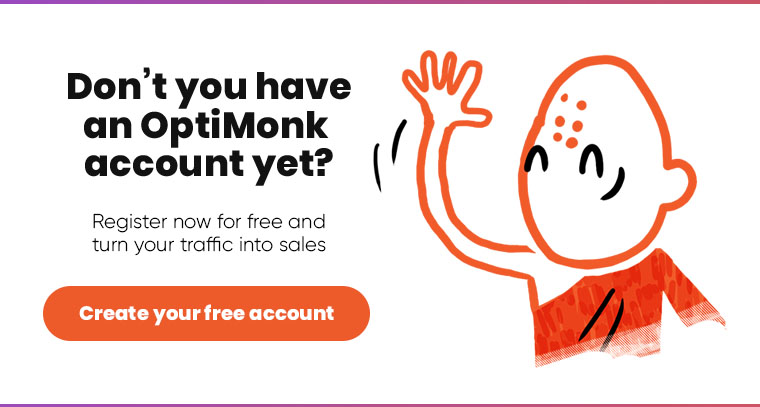Your customers are leaving, How dare they after you have spent so much time and effort to get them to your website 🙁 To understand why they are leaving you need to treat every web page like a leaving page using leaving page best practices.
Have you spent a fortune on advertising and provided great offers and yet feel that your ROI is underwhelming? If this is your situation then you are probably more than a little frustrated.
Don’t worry, you’ve come to the right place.
Please know you are not alone, just one of the many who turn to OptiMonk for a solution on a daily basis, this blog will help you to personalize your content and increase your website conversion rate.
If you are only getting a 2-3% conversion rate then yes, you have a problem, but it’s fixable.
In order to be successful in ecommerce for the long term, you need a far higher return than just average (2-3% conversion rate) provides. You need to be constantly growing.
Throwing money at advertising is not the solution, you’ve probably already tried this approach and so you know this, no, – what you need to determine is what you are missing, because you are certainly missing something. Often this is a failure to start properly or a case of trying to run before you can walk.
Let’s not get ahead of ourselves here. Let’s find what you are missing.
What you need is a way to stop your website visitors from leaving! Easy, right? 🙂
You know what they say hindsight 20/20 and all that, well by the time you leave this article you will know exactly what to do next.
The best place to start is to look at your analytics data to learn more about why your website visitors are coming in the first place. Now here you might think that the answer is obvious, “they come to buy our product” although is not incorrect, also it’s not the answer you need. What you need to understand is:
- Why do they need this product?
- Why do they need this product from you? What is your USP?
You need to provide them what they are looking for in the context of their motivation.
Your goal here is to map out interest groups, then determine what content you are missing for each interest group (gap analysis). Then create a logical progressive journey for each group comprised of knowledge steps. You need to understand entry points (for first-time visitors) for each and every persona and prepare the subsequent steps. You also need to understand why they leave without buying in order to disrupt the customers thinking and provide additional value.
Essentially what we are doing with this process is creating a customer journey map, this, in turn, enables improved personalization and helps you to start a conversation throughout the customer journey, making every page a micro-conversion point and treat every page as a leaving page. Here the goal is two-fold.
- Prevent the visitor from leaving for as long as possible (if they have not purchased) by giving them more of what they want.
- Get their details before they leave so you can re-engage them later. Sometimes visitors have to leave even if they don’t want to.
Consequently, the answer to the question when is the best time to send email blasts, the answer is never in isolation, because it is counterproductive, and will hurt your email deliverability in the future.
Every Page is a Leaving Page
Every page provides the opportunity to provide a personalized message before they leave, a second chance to convert. At the heart of leaving page best practices is personalization based on the interest already shown by the visitor through their interaction with your website content, in addition to source data.
You can communicate with your customer in real time by using exit-intent tech, such as that provided by OptiMonk. This detects the visitor’s intention to leave (mouse movement to the little x on the browser tab), enabling the triggering of the display of a specific message or offer based on their stage within the conversion funnel as determined by the content consumed.
The best part about this technology is that there is much you can learn about your visitors, thereby providing your business with a direction, the next steps to take to make it more successful.
For every piece of content you have, or if you feel this is overkill, then for every content topic or each persona type, – create answers to questions your visitors are asking. Whatever they are looking for on your site, – create a short message with a compelling message (call to action, magnet lead) directing them to where you need them to go, the next step down the conversion funnel.
You know why they came to your website (the piece of content or product that brought them from the question they asked Google search), how your page is listed on Google will tell you a lot about their motivation.
There is also onsite search which can be tracked with GA if switched on. If your visitors are leaving then they probably didn’t find the answer/product they were looking for. Your exit intent message is your second chance to remedy this deficit. In order to do this, you need OptiMonk.
Using Leaving Page Best Practices to get the right Exit Intent Message across.
Like any content, you create for your website, your “stop leaving” message needs to be tested and refined. Essentially you are testing their motivation with every variation of the message (overlay/popup) you create and display. This testing is achieved through the process which is often referred to as AB testing, which alternates or split tests the variations of message against one another in order to find the optimal version. The trick here is to stay true to each defined persona in order to prevent displaying the wrong message. When new users first come to your website, inevitably the persona the individual falls into is broad, a catch-all if you like. There are certain types of data that can help greatly in placing your visitors in narrower segments..
Source
- Organic Traffic, – Website entry point (blog post or landing page)
- Paid Advertising – Where was your advertising and what was your message. For example Facebook provides the following for targeting:-
- Age
- Gender
- Location
- Interests
- Social Media – again what was your message/content that brought them?
All three of these source groups provide a wealth of information if you target your persona’s precisely. You need a different message for each persona, targeting their specific niche interests. In addition, you need to provide a great offer of some kind that would be an incentive to convert, tailored to the needs of each persona.
When I say convert, a conversion is not necessarily an exchange of money, but rather an exchange of something of value. For example, in exchange for your email, you will provide a great ebook, directly answering the questions related to the product you are trying to sell. We call these conversions, micro-conversions and these are a trust-building exercise. With each additional micro-conversion, they are more likely to convert for cash.
Conclusion
For each and every webpage on your website you need to consider why your visitors might leave on that specific webpage then A/B test exit-intent messages to find what works best in preventing them from leaving never to return (approx 97% do). These messages should address their motivation for visiting in the first place AND potential reasons why they are leaving. There are many psychological tools that can be used here to help convince users to convert, tools that can be included in the design of your messages. To understand these effects and how to design your messages please read more on this blog.
The continual testing of your visitors whether it be through AB exit-intent messages or through a customer feedback sentiment survey (NPS) enables you to pinpoint why customers are leaving and address the cause, and thereby reduce the number of visitors leaving. Ultimately the net effect is increased conversion. If this is not the result then you have identified your issue as being one caused by product related issues, perhaps your pricing is off or features are outdated.
If you don’t test you will never know how to improve what you offer and ultimately your ecommerce business will fail. Act now to stop losing customers.













